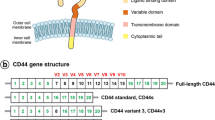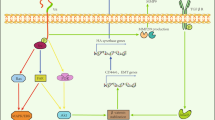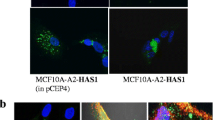The factors which lead to the formation of metastases are generally poorly understood; however the expression of a particular variant of the cell adhesion molecule CD44 may be important in facilitating metastasis formation in colon cancer. The aim of the present study was to investigate the expression of CD44 exon v 6 (CD44v6), hyaluronate (one of its ligands), and hyaluronate synthase, in a clinically relevant animal model of metastatic colon carcinoma. HT29 human colon carcinoma cells were injected subcutaneously between the scapulae of severe combined immunodeficient (SCID) mice and left for 3 weeks (by which time the tumours had produced metastases in the lungs). Morphological observations at the tumour-host interface were consistent with the dissociation of neoplastic cells from the primary tumours, and the ability of these cells to migrate through the extracellular matrix facilitating metastasis formation. Immunohistochemically detectable hyaluronate synthase expression was increased in vivo compared with the parent cell line in vitro. CD44v6 expression and hyaluronate were increased around single cells at the periphery of tumours compared with the central regions. CD44v6 and hyaluronate synthase expression were co-expressed in the same cells. Indeed, the present study is the first to demonstrate hyaluronate synthase expression by an epithelial cell type.
Similar content being viewed by others
References
Hart, IR, Goode, NR and Wilson, RE, 1989, Molecular aspects of the metastatic cascade. Biochim Biophys Acta, 998,65–84.
Heider, KH, Hofmann, M, Hors, E, et al. 1993, A human homologue of the rat metastasis-associated variant of CD44 is expressed in human colorectal carcinomas and adenomatous polyps. J Cell Biol, 120, 227–33.
Sleeman, J, Moll, J, Sherman, L, et al. 1994, The role of CD44 splice variants in human metastatic cancer. In: Ciba Foundation Symp 189. Cell adhesion and human disease. Chichester: J. Wiley, pp. 142–56.
Jalkanen, S, Wu, N, Bargatze, RF and Butcher, EC, 1987, Human lymphocyte and lymphoma homing receptors. Ann Rev Med, 38, 467–76.
Carter, WG and Wayne, EA, 1988, Characterisation of the class III collagen receptor, a phosphorylated, transmembrane glycoprotein expressed in nucleated human cells. J Biol Chem, 263, 4193–201.
Aruffo, A, Stamenkovic, I, Melnick, M, Underhill, CB and Seed, B, 1990, CD44 is the principal cell surface receptor for hyaluronate. Cell, 61, 1303–13.
Brecht, M, Mayer, U, Schlosser, E and Prehm, P, 1986, Increased hyaluronate synthesis is required for fibroblast detachment and mitosis. Biochem J, 239, 445–50.
Klewes, L, Turley, EA and Prehm, P, 1993, The hyaluronate synthase from a eukaryotic cell line. Biochem J, 290, 791–5.
De Angelis, PL, Papaconstantinou, J and Weigel, PH, 1993, Molecular cloning, identification and sequence of the hyaluronan synthase gene from group A Streptococcus pyogenes. J Biol Chem, 268, 19181–4.
Lansing, M, Lellig, S, Mausolf, A, et al. 1993, Hyaluronate synthase: cloning and sequencing of the gene from Streptococcus sp. Biochem J, 289, 179–84.
Prehm, S, 1994, Die Hyaluronatsynthase bei Streptococcen: Reinigung und Charakterisierung des aktiven Enzyms and der beteiligten Komponenten. Thesis Wilhelms-Universität, Munster, Germany.
Bumpers, HL, Alosco, TR, Wang, H-Q, Petrelli, NJ, Hoover, EL and Bankert, RB, 1994, Human villous adenomas engrafted into scid mice survive for prolonged periods without malignant transformation. J Clin Invest, 94, 2153–7.
Schumacher, U, Adam, E, Flavell, DJ, Boehm, D, Brooks, SA and Leathem, AJ, 1994, Glycosylation pattern of the human colon cancer cell line HT-29 detected by Helix pomatia agglutinin and other lectins in culture, in primary tumours and in metastases in SCID-mice. Clin Exp Metastasis, 12, 398–404.
Schumacher, U, Higgs, D, Loizidou, M, Taylor, I and Leathem, A, 1994, The lectin Helix pomatia agglutinin is a good prognostic marker in colon cancer. Cancer, 74, 3104–7.
Schumacher, U, Adam, E, Brooks, SA and Leathem, AJ, 1995, Development of clinically relevant models of metastasis using SCID mice and lectin defined human cancer cells. Surg Radiol Anat, 17, 183.
Knudson, W, Biswas, C and Toole, BP, 1984, Stimulation of glycosaminoglycan production in murine tumors. J Cell Biochem, 25, 183–96.
Toole, BP, Biswas, C and Gross, J, 1979, Hyaluronate and invasiveness of the rabbit V2 carcinoma. Proc Natl Acad Sci USA, 76, 6299–303.
Rooney, P, Kumar, S, Ponting, J and Wang, M, 1995, The role of hyaluronan in tumor neovascularisation. Int J Cancer, 60, 632–6.
Hudson, DL, Sleeman, J and Watt, FM, 1995, CD44 is the major peanut lectin-binding glycoprotein of human epidermal keratinocytes and plays a role in intercellular adhesion. J Cell Sci, 108, 1959–70.
Sofroniew, MV and Schrell, U, 1982, Long-term storage and regular repeated use of diluted antisera in glass staining jars for increased sensitivity, reproducibility and convenience of single- and two-color light microscopic immunocytochemistry. J Histochem Cytochem, 30, 504–11.
Lévesque, H, Girard, N, Maingonnat, C, et al. 1994, Localization and solubilization of hyaluronan and of the hyaluronan-binding protein hyaluronectin in human normal and arteriosclerotic arterial walls. Atherosclerosis, 105, 51–62.
Prehm, P, 1983, Synthesis of hyaluronan in differentiated teratocarcinoma cells. Biochem J, 211, 181–9.
Buehring, GC and Hackett, AJ, 1974, Human breast tumor cell lines: identity evaluation by ultrastructure. J NCI, 53, 621–9.
Luibel, FJ, Sanders, E and Ashworth, CT, 1960, An electron microscopic study of carcinoma in situ and invasive carcinoma of the cervix uteri. Cancer Res, 20, 357–461.
Hashimoto, K, Yamanishi, Y and Dabbous, MK, 1972, Electron microscopic observations of collagenolytic activity of basal cell epithelioma of the skin in vivo and in vitro. Cancer Res, 32, 2561–7.
Hashimoto, K, Yamanishi, Y, Mayens, E, Dabbous, MK and Kanzaki, T, 1973, Collagenolytic activities of squamous cell carcinoma of the skin. Cancer Res, 33, 2790–801.
Gabbert, HE, 1989, In vivo observations on tumor invasion. Molecular and cellular biology, host immune response and perspectives for treatment. In: Schirmacher, V and Schwartz-Albiez, R, eds. Cancer Metastasis. Berlin: Springer-Verlag, pp. 55–61.
Knudson, CB and Toole, BP, 1988, Epithelial-mesenchymal interaction in the regulation of hyaluronate production during limb development. Biochem Int, 17, 733–45.
Terpe, H-J, Stark, H, Prehm, P and Giinthert, U, 1994, CD44 variant isoforms are preferentially expressed in basal epithelia of non-malignant human fetal and adult tissues. Histochemistry, 101, 79–89.
Prehm, P, 1989, Hyaluronate is synthesised at plasma membranes. Biochem J, 220, 597–600.
Turley, EA, Moore, D and Hayden, LJ, 1987, Characterization of hyaluronate binding proteins isolated from 3T3 and murine sarcoma virus transformed 3T3 cells. Biochemistry, 26, 2997–3005.
Turley, EA and Torrance, J, 1984, Localization of hyaluronate and hyaluronate-binding protein on motile and non-motile fibroblasts. Exp Cell Res, 161, 17–28.
Stamenkovic, I, Aruffo, A, Amiot, M and Seed, B, 1991, The haemopoietic and epithelial forms of CD44 are distinct polypeptides with different adhesion potentials for hyaluronate-bearing cells. EMBO J, 10, 343–8.
Matsumara, Y and Tarin, D, 1992, Significance of CD44 gene products for cancer diagnosis and disease evaluation. Lancet, 340, 1053–7.
Bartolazzi, A, Peach, R, Aruffo, A and Stamenkovic, I, 1994, Interaction between CD44 and hyaluronate is directly implicated in the regulation of tumor development. J Exp Med, 180, 53–66.
Mulder, JR, Kruyt, PM, Sewnath, M, et al. 1994, Colorectal cancer prognosis and expression of exon-v6-containing CD44 proteins. Lancet, 344, 1470–2.
Koetz, K, Möller, P, Lehnert, T, Hinz, U, Otto, HF and Herfarth, C, 1995, Effect of CD44v6 on survival in colorectal carcinoma. Lancet, 345, 327–8.
Finke, LH, Terpe, H-J, Zörb, C, Haensch, W and Schlag, PM, 1995, Colorectal cancer prognosis and expression of exon-v6-containing CD44 proteins. Lancet, 345, 583–4.
Author information
Authors and Affiliations
Rights and permissions
About this article
Cite this article
Mitchell, B.S., Whitehouse, A., Prehm, P. et al. CD44 exon variant 6 epitope and hyaluronate synthase are expressed on HT29 human colorectal carcinoma cells in a SCID mouse model of metastasis formation. Clin Exp Metast 14, 107–114 (1996). https://doi.org/10.1007/BF00121207
Received:
Accepted:
Issue Date:
DOI: https://doi.org/10.1007/BF00121207




